When Wildness Goes Bold
March 26, 2021



 SCA Articles
SCA Articles
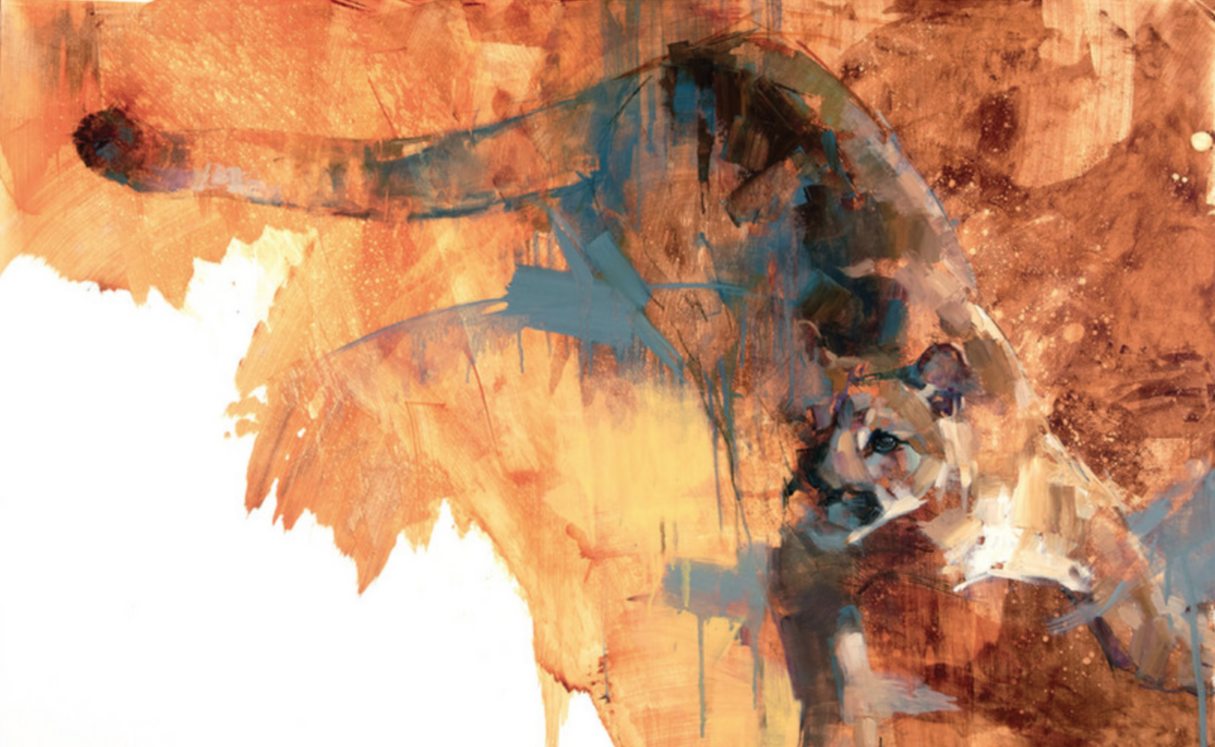
Painter Julie Chapman ushers forth the exciting new era of wildlife art.
In any great wildlife painting, viewers do not just feel the spirit of an animal, we’re making contact with the mind’s eye of a brilliant artist. Julie T. Chapman, in her acclaimed multi-media scenes and monochromatic scratchboards, demonstrates how a single image can shape the mood of an entire room.
On the day we spoke, a new work—a portrayal of a canid-toothed predator—was coming off the easel being packaged and sent to an eagerly-awaiting collector with the paint barely dry. To get a sense of Chapman’s work, all you need is consider two bold examples.
With Rebound (Carpe Diem #2), she explains that she “is trying to capture the intense grace and athleticism of a cougar in pursuit of prey.” And, in the massive 4×4-foot gem, Two Hearts One Love, she introduces us not to the mythical wolf of fairy tales, but the modern lobo, emblem of how modern conservationists have been willing to put an important, albeit controversial, piece of wildness back in place. Undeniable is the painting’s impact, irrefutable is its drama, but there’s nothing neat, tidy or predictable.
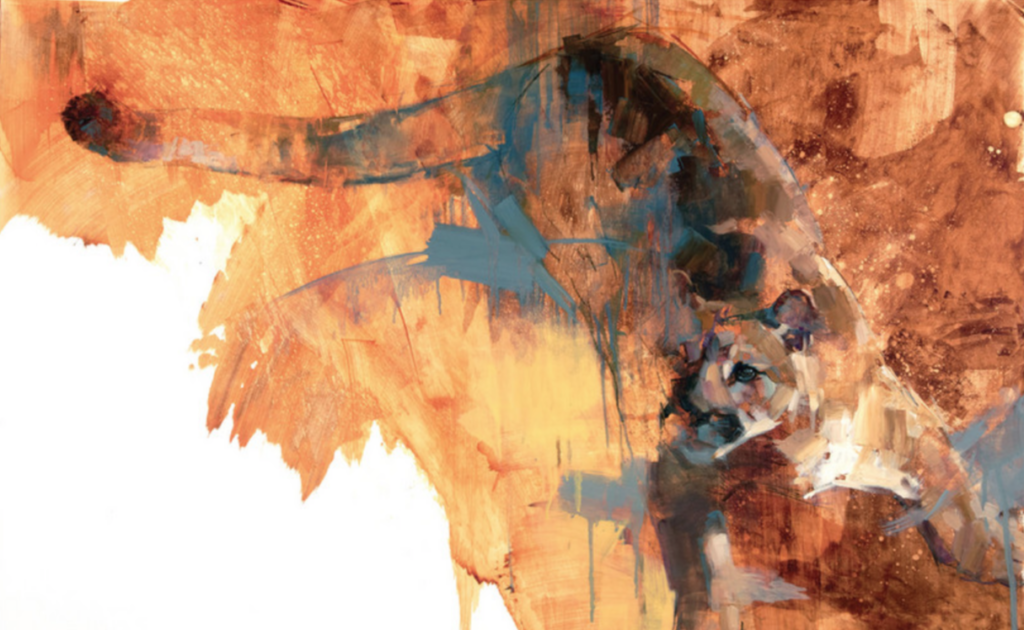
A few short years ago, this contemporary American master, who lives in the Northern Rockies in a forested place not far from where she keeps riding horses, had a breakthrough. Chapman’s shift to what she calls “disrupted realism” transported her from being known as a talented portrayer of wildlife and Western ranch scenes, to becoming known as an artist who is now seizing national attention and leaving longtime collectors, even friends, astounded.
“Something is going on within her abstract thinking that is beyond the range of most artists,” says noted Wyoming wildlife painter Greg Beecham who has co-taught art workshops with Chapman. “When painters evolve, as she has, there is a risk of losing something as they move into a new way of seeing,” he adds. “Julie, while delving into abstraction, has not left her impressive drawing skills behind. She’s not lost or given up anything. Instead she’s bringing the full force of her talent forward.”
A common criticism of a lot of contemporary and traditional wildlife art is that it looks formulaic or “over-rendered,” i.e. as if the artist did not know when to stop applying brushstrokes or the portrayal seems to be replicating a photograph.
Many artists paint scenes in which every square inch of canvass is covered because they dare not consider an alternative. Chapman’s compositions deliver a more open-ended story, allowing our own imaginations to wander—and wonder—what the subject will do next, just like large quadrupeds behave in nature.
“I want my work to be evocative and I realize I am asking a lot of my viewers, but the intent is inviting them to participate with what’s happening between the frame and to contemplate the significance of the animal in their own minds,” Chapman says.
Chapman pays attention to the energy of excitement that comes with being on the hunt, and each work on the wall offers something new visually on every encounter, based on animals she has observed and studied in North America or Africa. Did you know the eye color of wild wolves can occur in different hues depending on genetic makeup, the same as is true for human beings? Chapman does.
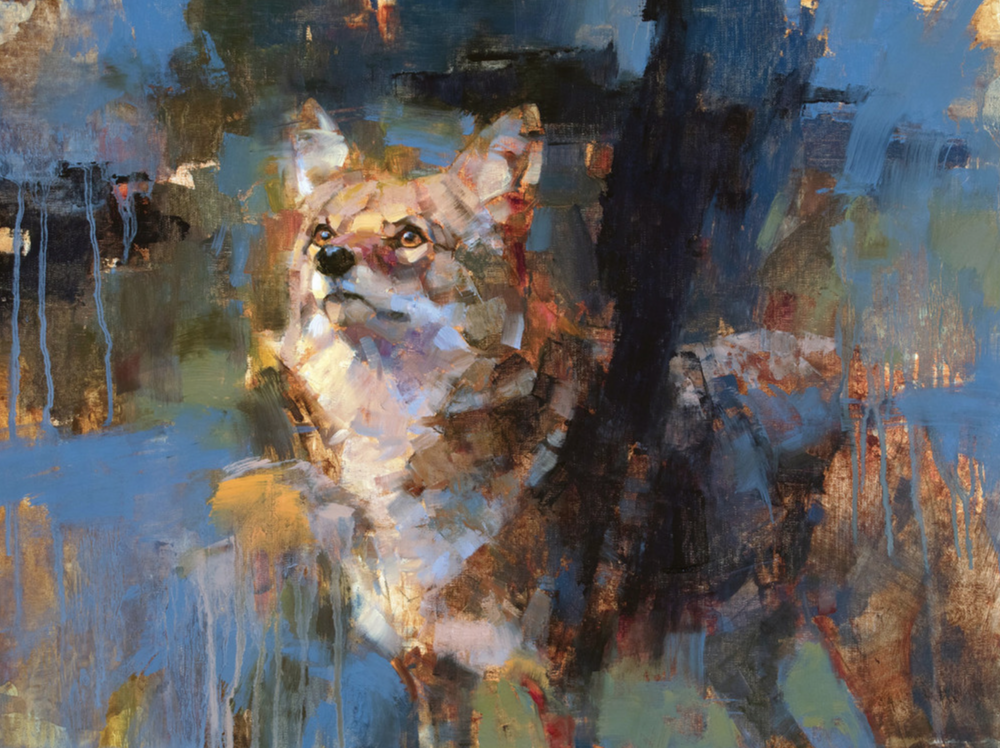
How many of us realize that the primordial, spine-tingling sensation we feel when standing before a lobo— catching sight of the reflected burning sunlight on its iris—is the same thrill that awaits in close encounters with grizzlies, African lions, Cape buffalo or bull elk as the latter’s nostrils fume steam into the cold airy heights of a mountain autumn? She has absorbed it as an eye witness herself.
“The ‘incompleteness’ of my subjects also feels to me as if it is revealing something more elemental, more essential, perhaps reflecting my own deep emotion and love for the animals I paint,” she says. “These pieces require a deep, wordless conversation; they demand more from me than any other body of work I’ve done before, and I frequently struggle with self-doubt in the process, yet each painting when it works is deeply satisfying.”
Growing up in the Midwest, Chapman is, by origin, a farm girl who rode horses in equestrian events and has carried a sixth sense for animal behavior and anatomy forward. Sketching and drawing were always part of her interpretive process, but it would take a while, however, before she was in a position—and a place—to embrace painting as a career.
Gifted with an analytical mind, she majored in computer engineering at Case Western Reserve University and then worked in Silicon Valley’s high-tech industry through the early years of the new millennium.
While designing software earned her a solid income, she wasn’t satisfied. Living in northern California, Chapman became increasingly aware of how fragmented the human-dominated natural landscapes were, which is why she relates to wildlife that needs plenty of space.
Chapman painted when time allowed, and she’d often gather photographic reference material on vacation forays to wild country. During a wildlife-watching trip to Alaska, she had a series of spectacular days observing brown bears.
In 2003, a painting of a bruin was accepted into the prestigious Arts for the Parks national painting competition and it won the grand prize that delivered not only $50,000 but widespread recognition. Boosting her confidence, Chapman gave up her job. She and her husband moved to western Montana “so that I could be closer to the wild places where most of my subjects lived.”
Steadily, her reputation grew. She was invited to exhibit works at a number of prominent museum and gallery shows. Along with painting in oil and acrylic, Chapman also took up scratchboard—an exquisite Old-World cousin of etching that requires skill in drawing and compositional design.
Fast-forward a decade. Although Chapman was counted among the rising stars of wildlife art, in 2018 she began experimenting with abstracted shape and color. On a whim, she shared a study portrayal “of a white horse with a bunch of blue-grey-green abstraction” on social media. The response, she said, was swift—and affirming. After she completed a big easel painting of the same scene it sold within a few hours for a considerable amount of money.
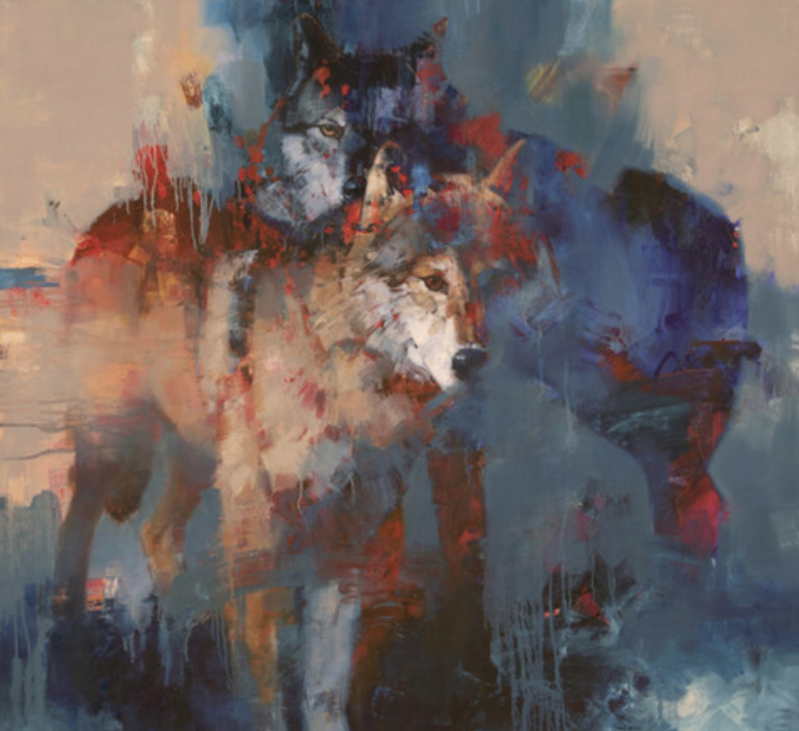
At Rowe Gallery in Sedona, Arizona, it’s hard to keep Chapman’s work on the wall, says gallery founder Ken Rowe who has shipped paintings all over the country after they’ve been purchased literally within hours of their arrival.
“I’ve told Julie that she’s a genius. She’s helping to take wildlife art in a fresh, invigorating direction and it is meeting with enthusiasm from across the spectrum,” Rowe says. “She’s connecting with every age group of art collector—customers I’ve had for over 20 years, those who normally like traditional wildlife art, and also younger people with contemporary tastes.”
Chapman, who earlier in her career won rare praise from the late Bob Kuhn, has been compared to a number of legendary artists who became known for their non-traditional approach to portraying wildlife, including the late LeRoy Nieman and Native American master John Nieto, whom Rowe represented. That she’s friends with Beecham and the two give each other unflinching critiques shows that she wants to be pushed.
Beecham has many collectors who are avid hunters and he was recently was featured in this magazine. When reflecting on Chapman, he alludes to the cliché of wildlife art, that in order for artists to get better they need to “loosen up” and move away from the stiff, tight portrayals of wildlife that look like they were inspired by a camera lens. “I’ve seen it happen with many painters, that when they become looser in their technique they stop doing the hard work of drawing and they become dabblers,” Beecham says. “What Julie does requires absolute concentration and thought. What she’s doing is much harder than any other kind of realism, but she has the talent to pull it off.”
While known for his ability to articulate the profound elements of fine art, Beecham says it’s difficult to find appropriate exacting words to describe where Chapman is. “She is an enigma because Julie thinks like an engineer but most engineers tend not to be that artistic or imaginative,” he says. “In the years I’ve known her, she has been incredibly talented all along, and has known how to put together a good painting, but she is now at a whole new level. I wish I had her vision.”
Gesture and form of the animal are what excites Chapman most, she says. While one way of describing the appearance of her painting is “fragmentation” of the ordinary, it is not jarring but soothing with color harmony, emanating a sinuosity of flow like riverine rapids, the kind that allures from across a room.
Even with her success, Chapman has high standards and does not believe her creations are too precious that a promising painting can’t be redone, improved upon or added to a stack of attempts that are burned. Where some artists might ship a subpar work off to a gallery, knowing it will sell, she won’t hesitate to take a palette knife and scrape away layers of painted texture or wipe a surface clean with turpentine.
Chapman has won awards for her horse and rodeo scenes at the Calgary Stampede and praise from people with horse paintings by famous artists in their collection. “I adore my horses and will always come back to them. They are the vehicles by which I experiment and explore symbolism.”
Of the inspiration for her body of work based on research trips to Africa and western North America, she says, “The subjects in my pieces are usually placed in an abstract setting, often looking out at the viewer; they are inescapable, even confrontational, and they challenge us to consider our relationship to the animal and natural worlds,” she explains. “They also reflect the pure joy I feel when I am doing field work, observing wildlife or standing in the dust at the edge of a rodeo arena, itching to capture my excitement in art.”
Painter Carrie Wild, who owns Gallery Wild, says that in a community such as Jackson Hole that has a high standard for wildlife art and is home to the National Museum of Wildlife Art, Chapman stands out.
“Chapman sees wildlife differently than most of her contemporaries do,” Wild says, “and then she paints the vison. By becoming engaged by her work, we are able to see animals differently, too.” In Chapman’s attention-grabbing interpretations, we feel the flourishes of big game animals we encounter in the field, the intensity of their presence and even perhaps the reason why those species loom larger in the imagination of our modern lives.
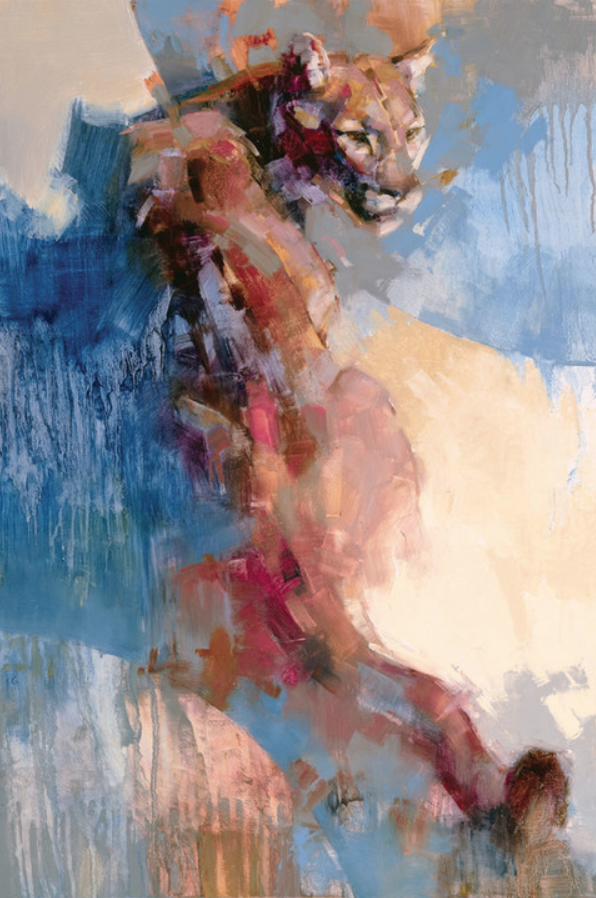
The former computer nerd is proud to live in a region that has placed a premium on understanding the connection between habitat protection and healthy wildlife populations, with Montana and Wyoming together able to claim a remarkable place in the Lower 48. They are the only two states where all of the original mammals —both predators and prey—that were present in the West 500 years ago when Europeans arrived on the continent, are still able to roam across the landscape.
Hunters, Chapman says, appreciate the diversity of animals found in healthy ecosystems. In 2019, she launched a new ongoing series, “Vanishing Ark,” prompted by a global scientific report that predicted, because of land development taming wild country, climate change affecting habitat and pressures such as overfishing in the oceans, a million or more species could go extinct by the end of the century. She is not an artist afraid to tout conservation.
Chapman is friends with elk hunters who, over time and even after being initially opposed to having wolves regain a presence in the West, admit that hearing a pack howl, and sharing the primordial experience with their family, adds a thrill to the backcountry that their grandparents did not know. Her works have become conversation pieces in collectors’ homes, with married couples desiring to make them focal points in their dens and great rooms.
“We, as a society, invest so much symbolism and emotion in wolves, perhaps because there are many similarities between our two species; each of us being family-oriented, group-oriented, territorial, top of the food chain and, of course, intelligent,” she says, reminding that every breed of beloved domestic dog is descended from Canis lupus. “Wolves are who they are, crafted by time for their duty as predators, and when a wolf looks at you, you know there is a fully present consciousness there.”
Chapman hopes her art and portrayals of large iconic species will light the spark of advocacy among urban inhabitants who might not understand or appreciate untrammeled landscapes as sportsmen and women do. “Whatever our pathway to the great outdoors is,” she says, “we’re in this together and concern for the natural world should unite us, not divide us.”
